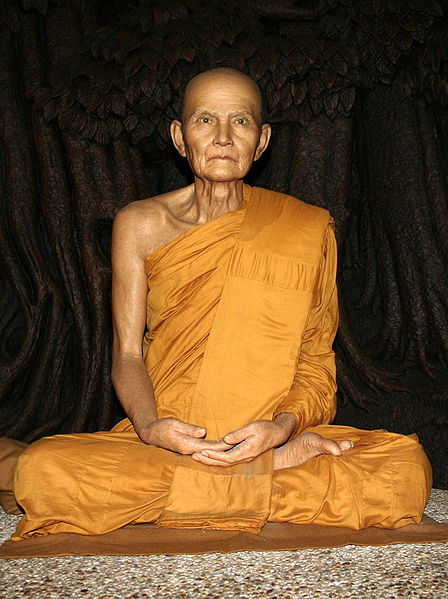
The Ballad of Liberation from the Khandhas
by Phra Ajaan Mun Bhuridatta Mahathera
Introduction
Phra Ajaan Mun Bhuridatta Mahathera (1870-1949) was by all accounts the most highly respected Buddhist monk in recent Thai history. Ordained in 1893, he spent the major part of his life wandering through Thailand, Burma, and Laos, dwelling for the most part in the forest, engaged in the practice of meditation. He attracted a large following of students and — together with his teacher, Phra Ajaan Sao Kantasila Mahathera — was responsible for the establishment of the forest ascetic tradition that has now spread throughout Thailand and to several countries abroad.
Despite his fame as a teacher, very few of his teachings were recorded for posterity. Only one slim book of passages drawn from his sermons, Muttodaya (A Heart Released), was published during his lifetime. His students generally believed that he himself never wrote down any of his teachings, but at his death the following poem was found among the few papers he left behind. As he noted on the final page, he composed it during one of his brief stays in Bangkok, at Wat Srapatum (LotusPond Monastery), probably in the early 1930’s. He was apparently inspired by an anonymous poem on the theme of meditation composed and printed in Bangkok during that period, for both poems share virtually the same beginning — the 39 lines in the following translation beginning with, “Once there was a man who loved himself…” Ajaan Mun’s poem, however, then develops in an entirely original direction and shows by far a deeper understanding of the training of the mind.
Translating the poem has presented a number of difficulties, not the least of which has been getting a definitive reading of the original manuscript. Ajaan Mun wrote during the days before Thai spelling became standardized, some of the passages were smudged with age, and a few seem to have been “corrected” by a later hand. Another difficulty has been the more general problem of finding the proper English style for translating Thai poetry, which depends heavily on rhyme, rhythm, and a stripped-down syntax, somewhat like that of telegrams and newspaper headlines. This style gives Thai poetry a lightness of style combined with a richness of meaning, but frustrates any attempt to pin down any one precise message for the sake of translation — an excellent lesson for anyone who feels that the truth is what is conveyed in words.
The following translation is meant to be as literal as possible, although I have fleshed the text out when it seemed necessary to make the English intelligible. Because the original alternates between two poetic forms — klon and rai — I tried to create a similar effect in English by alternating blank verse and free verse. The result is probably too literal to be poetry, but I felt that anyone reading it would be more interested in the meaning than in verbal effects. The instances where I have taken the most liberty with the text have been included in square brackets, as has one passage — ironically, dealing with the error of being addicted to correcting things — where the reading of the original seems to have been doctored.
The reader will notice that in a few places the poem seems to jump abruptly from one topic to another. In some cases these shifts were dictated by the rhyme scheme, but in others they are not really shifts at all. Keep in mind that the poem operates on several levels. In particular, two parallel themes run throughout: (1) an analysis of the external error of focusing on the faults of other people instead of one’s own, and (2) a discussion of the mind’s internal error of viewing (and criticizing) the khandhas as somehow separate from its own efforts to know them. Statements made directly about one level apply indirectly to the other as well. Thus the poem covers a wider range of the practice than might appear at first glance. It’s a work that rewards repeated readings.
I would like to express my gratitude to Phra Ajaan Suwat Suvaco (Phra Bodhidhammacariya Thera) for the invaluable help he gave me in untangling some of the knottier passages in the poem. Any mistakes that may remain, of course, are mine.
Metta Forest Monastery
Valley Center, CA 92082-1409 U.S.A.
Glossary
Dhamma:
- In general, this word has several levels of meaning: the way things are in and of themselves, the Buddha’s teachings about the way things are, the practice of those teachings in training the mind, and the attainment of Deathlessness as the goal of the practice. In this ballad, ‘Dhamma’ usually has the final meaning. The nine transcendent Dhammas are the paths and fruitions of each of the four stages of Awakening — stream-entry, once-returning, non-returning, and arahantship — plus nibbana (nirvana).
Jhana:
- Concentration; meditative absorption in a physical sensation or a mental notion.
Kamma:
- Intentional acts that lead to renewed states of becoming and birth.
Khandha:
- Component parts of sensory perception: rupa (physical phenomena); vedana (feelings of pleasure, pain, or indifference); sañña (concepts, labels, allusions); sankhara (mental fashionings, formations, processes); and viññana (sensory consciousness).




